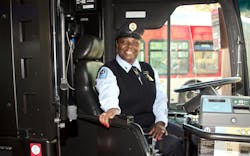In the fight against assaults there are ways for transit agencies to protect their bus operators. Agencies can install security cameras, call buttons to alert police and install bus barriers. Operators can face many different types of assault, and according to Brendan Danaher, the director of government affairs for the Transport Workers Union (TWU), some types of assault go unreported.
“For us and for many of the people that we represent, the biggest concern right now is bus operators who are subject to assault on a regular basis. In fact, depending on how you define assault, it is so common that sometimes people don’t even report it, verbal assaults and being spat on are things that happen maybe daily – certainly weekly. So it’s difficult to determine what those numbers are, but as you get into more dangerous and severe types of assault, whether that’s brandishing a weapon or being sprayed with mace or actually being punched or physically assaulted. Those do get reported,” said Danaher.
Danaher said that TWU has been advocating for the installation of bus barriers after discovering through research that many assaults stem from fare collection.
“This may be people who are drunk or otherwise impaired or they may be people who have some mental illness, but they are often angry about collecting fares or delays or service cuts and they take those issues out on the drivers. So installing a plexiglass barrier between the operator and the passengers is one of the most successful solutions that we’ve found,” said Danaher.
Agencies including the Los Angeles Metropolitan Transportation Authority (Metro) has launched a number of safety campaigns and has been adding safety features to its buses.
Paul Gonzales, senior media relations officer, Metro explained, “In late 2013, Metro began the process of retrofitting our buses with a steel and polycarbonate barrier that protects the driver from assault. We leave it up to the operator to decide if they want to close the barrier or not. Since that time, all our new buses are delivered with an operator barrier from the factory.”
Gonzales also said that Metro came across the same findings that the main cause behind altercations was fare dispute. Metro then automated the fare announcement in the hopes that that would reduce the number of those instanced between operators and passengers.
Developing features of barriers
Vapor Bus International a Wabtec Companies offers bus barrier, protection doors that are meant to block both direct physical assaults as well as any objects that passengers throw at the bus operators.
Danaher said that TWU feels that not all barriers are equal, he said that barriers need to be designed to fit into different bus designs. “There do need to be some considerations so that other issues don’t come up as a result to these barriers; an HVAC that filters environmental stuff and preventing glare or reflection because that makes driving dangerous.”
John Condon, VP, Vapor said “The Vapor bus operator protection door integrates 2 variable-speed, high velocity electric fans that can assist in cockpit air circulation. Fans can be configured out/out, in/out or in/in operation. An electric powered window allows for increased airflow and ventilation, and permits operator and passenger verbal interaction.”
Danaher added that while bus barriers need to provide protection, there needs to be a way for the operator to exit easily and safely. “Even the way in which these doors open are an issue, if someone uses mace or another flammable material that driver needs to get out of that plexiglass barrier really quickly”
Condon said that Vapor has an installed emergency release features. “A large, easy reach, door latch release handle is used by the operator to open the door.”
Condon said that Vapor is currently working with several agencies to install porotype units.
Emphasizing safety in other areas
Besides implementing bus barriers, agencies have found success in other areas.
“Metro began installing monitor on buses to show a live feed from all on-board CCTV cameras. The concept is if a person sees himself on a monitors he knows he’s being recorded and is less like to commit a crime. The monitors have been successful in reducing operator assaults,” said Gonzales.
Danaher said that after reading transit studies he also found that informing people they are being recorded. “People then start to understand that they cannot act by impunity and those are important as are policing issues, to get police to the area quickly.”
Transit agencies have also put to use DNA swabs, Danaher said that TWU has seen London put that to use. It gives the transit authority a way to identify offenders. Another important factor in preventing operator assaults, is training operators themselves.
“Metro also conducted a pilot program with Transit Ambassador, a customer service curriculum owned by the Canadian Urban Transit Association. The curriculum contains modules that teach operators skills to defuse potentially dangerous situations in the field. The results were inconclusive,” said Gonzales.




